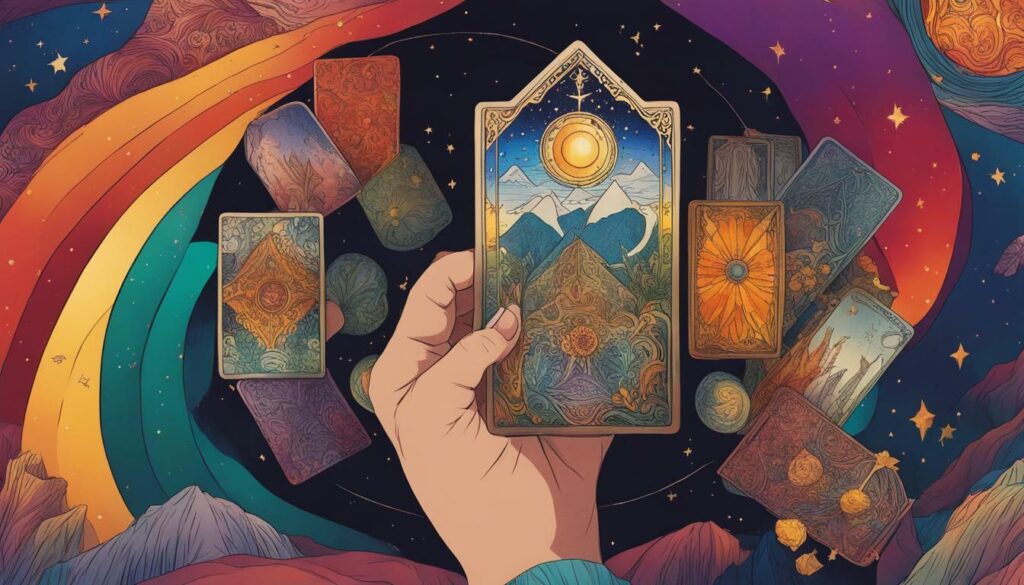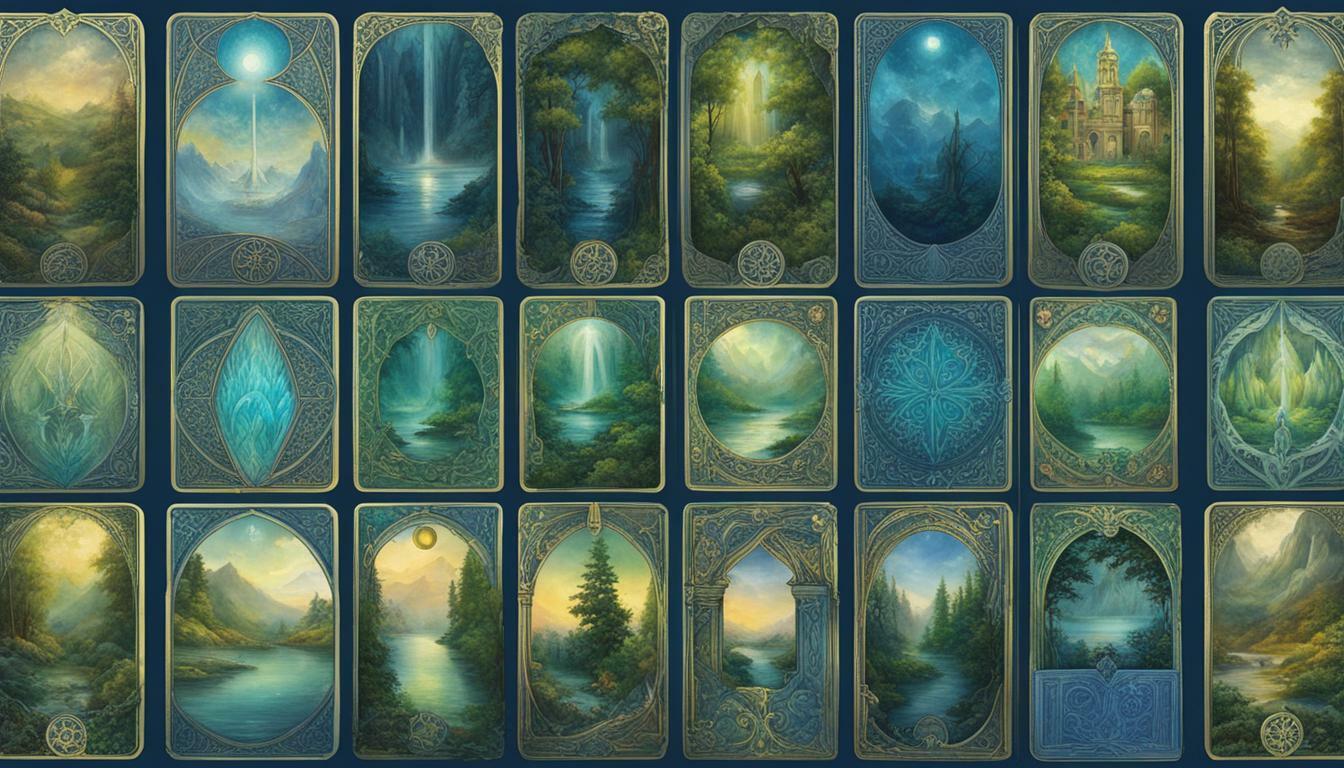Tarot readings can be a powerful tool for gaining insights into our past experiences and how they have influenced us. Color symbolism plays an essential role in tarot, and understanding its significance can unlock a deeper level of meaning in tarot readings.
When we ask about our past influences and lessons with tarot, color interpretations can provide a unique perspective, shedding light on aspects of our experiences that we may not have understood before.
Key Takeaways:
- Color symbolism is a crucial element of tarot readings.
- Understanding color interpretations can provide insights into past influences and lessons.
- Using color effectively in tarot readings can empower us to gain a deeper understanding of our past experiences.
Understanding Tarot Card Meanings and Color Symbolism
When it comes to tarot readings, each card has a specific meaning and significance. However, did you know that the colors present on these cards are also extremely important? Color symbolism has been utilized in the tarot for centuries, and understanding the meanings behind different colors can enhance your interpretations of the past influences represented by specific cards.
Let’s take a closer look at some of the most common colors represented in tarot cards and their associated meanings:
| Color | Meaning |
|---|---|
| Red | Represents passion, energy, and action. It is often associated with the Suit of Wands, which signifies creativity and ambition. |
| Blue | Represents knowledge, wisdom, and communication. It is often associated with the Suit of Swords, which signifies intellect and mental agility. |
| Green | Represents growth, abundance, and fertility. It is often associated with the Suit of Pentacles, which signifies material possessions and financial stability. |
| Yellow | Represents optimism, joy, and inner strength. It is often associated with the Suit of Cups, which signifies emotions and relationships. |
These are just a few examples of how color symbolism plays a significant role in tarot card meanings. By incorporating an understanding of color into your tarot readings, you can deepen your interpretations and gain a more nuanced understanding of past events and experiences.
Next up, we’ll explore the history of color usage in the tarot and the cultural significance of different colors in various tarot traditions.

Exploring the History of Tarot and Color Usage
When it comes to tarot readings, color symbolism plays a significant role in interpreting past events and experiences. But where did this tradition come from? Let’s take a look at the history of tarot and how colors have been used in tarot decks throughout time.
The tarot deck as we know it today originated in Italy during the 15th century. Originally used for playing games, it was later used for divination and spiritual purposes. Over time, the tarot deck evolved to include various symbols and imagery, including colors that had significant meanings. In the early days of tarot, decks were hand-painted, with each artist adding their own interpretations and unique color choices. This led to variations in color symbolism across different tarot traditions.
One of the earliest known tarot decks is the Visconti-Sforza deck, created in the mid-15th century for the Duke of Milan. This deck features intricate designs and gold leaf accents, with each card containing elements of color symbolism. For example, the Magician card features a red cloak and white roses, symbolizing power and purity.
As tarot decks became more popular throughout Europe and the United States during the 19th and 20th centuries, different artists and designers started to create their own variations. This led to a diversification in the use of color symbolism, with some decks featuring more vibrant colors and others relying on more muted tones.
Today, the use of color in tarot readings remains a popular practice. Whether you’re using a traditional deck or a modern variation, understanding the history of tarot and color symbolism can provide a deeper appreciation for the spiritual significance of tarot readings.

Exploring the Cultural Significance of Color Symbolism in Tarot
One of the most intriguing aspects of color symbolism in tarot is how it varies across different cultures and traditions. For example, in many Eastern cultures, the color red symbolizes good luck and fortune, whereas in Western cultures it is associated with passion and power. Similarly, the color blue is often associated with relaxation and calmness in Western cultures, whereas in Hinduism it is associated with the god Vishnu and represents strength and energy.
These cultural differences in color symbolism are reflected in the various tarot traditions. For example, in the Rider-Waite-Smith tarot deck, which is one of the most widely used decks today, the Fool card features a yellow tunic, representing the innocent and optimistic nature of the Fool. In contrast, in the Thoth deck created by Aleister Crowley, the Fool wears a multicolored tunic, which represents the infinite possibilities and potential of the Fool.
By understanding the cultural significance of color symbolism in tarot, you can gain a deeper appreciation for the meanings behind specific tarot cards and colors.
Using Color in Tarot Readings for Past Influences
Now that we have explored the significance of color symbolism in tarot and the meanings behind different tarot cards and their associated colors, let’s get into how we can use color effectively in our tarot readings to gain insights into past influences and lessons.
Firstly, it’s important to pay attention to the colors present in the tarot cards you draw. Take note of any patterns or recurring colors. These colors can be linked to specific past events or experiences that have influenced your current situation.
For example, if you repeatedly draw cards with shades of blue, this could signify that past emotional experiences are still affecting your present situation. Additionally, shades of red can signify past conflicts or passions that have influenced your current state of affairs.
It’s also essential to consider the context of the card’s position in a spread when interpreting color symbolism. The same color can have different meanings depending on its placement in the spread. For instance, if a red card appears in the “past” position of the spread, it could indicate a past event that still influences your present situation. However, if it appears in the “future” position, it could signify a future event that may evoke similar emotions or experiences.
Don’t be afraid to trust your intuition when interpreting colors. Sometimes, a color may speak to you in a way that doesn’t necessarily correspond to traditional color symbolism in tarot. Trust yourself to make creative and intuitive connections between colors and past influences.
Applying color symbolism to tarot readings can provide deep insights into past experiences and their influence on our current situations. As we continue to explore color and past influences in tarot, we can develop a deeper understanding of ourselves and our life paths.

Next, we will delve deeper into the process of analyzing colors in tarot to uncover past influences and lessons. Read on to discover a framework for conducting your color analysis in tarot readings.
Uncovering Past Influences Through Color Analysis
When conducting a tarot reading focused on past events and experiences, color analysis can provide powerful insights. Each color has its own symbolic meaning, and when combined with the interpretation of the tarot card, it can reveal hidden influences and lessons from the past.
One way to analyze color in tarot is to look at the color combinations present in the cards. For example, the combination of red and black can represent intense emotions and conflicts, while green and gold may indicate abundance and prosperity.
| Color Combination | Interpretation |
|---|---|
| Red and Black | Intense emotions and conflicts |
| Green and Gold | Abundance and prosperity |
| Blue and Silver | Spiritual growth and intuition |
It’s also important to consider the specific colors present in the tarot cards. For example, the color red is often associated with passion and energy, while blue represents calmness and intuition. By interpreting the colors in relation to the tarot card, you can gain a deeper understanding of the past influences and lessons represented by the card.
Additionally, the position of the card within the tarot spread can provide further insight into the meaning of the color. For example, if a card with a lot of red appears in the “past” position, it may indicate a period of intense emotion or passion in the past.

Through color analysis in tarot, we can uncover hidden past influences and lessons that may have otherwise gone unnoticed. By interpreting the colors in relation to the tarot card and positions in the spread, we can gain a deeper understanding of our past experiences and how they have shaped us.
Conclusion
In conclusion, understanding the history of tarot and its connection with color symbolism can provide valuable insights into past experiences. By incorporating color interpretations in tarot readings, we can gain a deeper understanding of past influences and lessons.
Tarot history has shown us that the use of color in tarot decks has evolved over time, reflecting cultural and spiritual changes. By exploring the symbolism of color in tarot, we can connect with the wisdom of our ancestors and tap into the spiritual power of the cards.
In our own tarot practice, we can use color analysis to uncover the meaning behind past events and experiences. By interpreting the colors present in specific tarot cards and positions in a spread, we can gain a more comprehensive understanding of our lives.
At its core, tarot is a tool for self-discovery and personal growth. By incorporating color symbolism in our tarot readings, we can deepen our connection with ourselves and the world around us. We encourage you to explore the depths of your own past experiences through the lens of color and unlock the power of tarot.
FAQ
Q: How can I use color to ask about my past influences and lessons with tarot?
A: Using color in tarot can provide insights into past events and experiences. By understanding the symbolism of different colors, you can deepen your understanding of the past influences represented by specific tarot cards. Incorporating color analysis into your tarot readings can help you gain a clearer picture of your past and the lessons it holds.
Q: What is the significance of color symbolism in tarot readings?
A: Color symbolism in tarot readings adds an additional layer of meaning and interpretation. Colors can evoke specific emotions and convey different energies. By paying attention to the colors present in a tarot reading, you can gain a deeper understanding of the messages and influences being conveyed through the cards.
Q: How does color play a role in understanding past influences in tarot?
A: Color can be used as a tool to uncover hidden meanings and insights into past influences in tarot. Different colors have different associations and can represent various aspects of past events. By analyzing the colors in a tarot reading, you can gain a clearer understanding of the past experiences that have shaped your current situation.
Q: How do I interpret colors in relation to specific tarot cards and positions in a spread?
A: Interpreting colors in tarot requires a combination of intuition and knowledge of color symbolism. Each color has its own unique significance, and the way it interacts with specific tarot cards and positions in a spread can provide valuable insights. Practice and familiarity with color interpretations will help you develop a deeper understanding of how colors contribute to the overall message of a tarot reading.
Q: Can color analysis in tarot readings uncover past influences and lessons?
A: Yes, color analysis in tarot can help uncover past influences and lessons. By examining the colors present in a tarot reading and exploring their symbolism, you can gain a deeper understanding of the experiences that have shaped your past. Color analysis adds richness and depth to tarot readings and can provide valuable insights into your personal journey.

